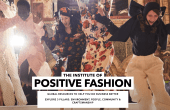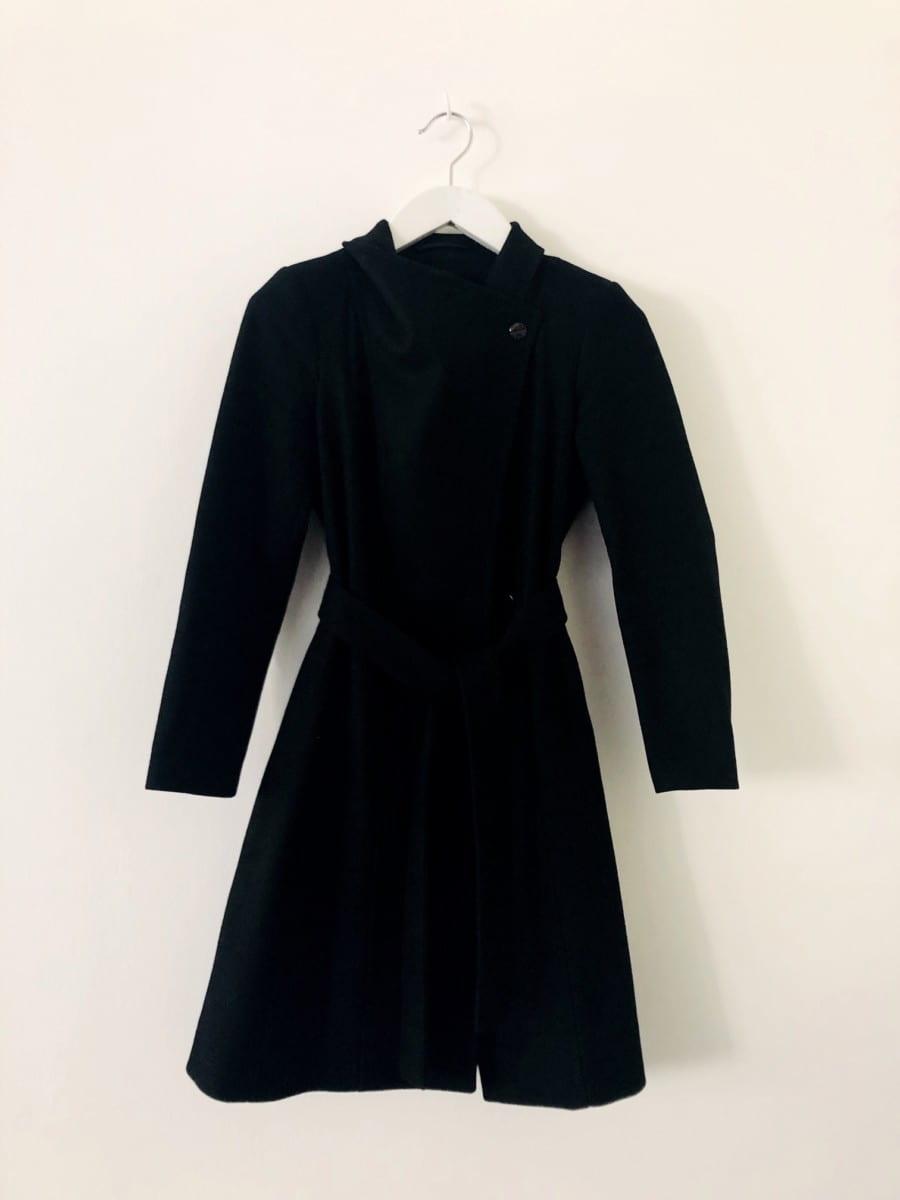Those who follow me on Twitter will know that a couple of weeks ago I did a TED talk as part of TEDx Whitehall. It was extremely nerve wracking, but I was so pleased I managed to get through it. For my talk, I decided to speak about the importance of fashion. I discussed the fact that whilst fashion has its problems, ethically and environmentally, it can also be a force for change, there are now bras that can detect cancer, clothes that clean the surrounding air and 3D-printed fabrics. It’s time to forget frivolity and start thinking much more seriously about what it is we wear.
I hope to post the film of my talk next week, so stay tuned!

How long did each of you spend deciding what to wear today? 5- 10 minutes? A recent survey found that the average woman spends 16 minutes and tries on two outfits every morning before coming to a decision – half of them have spent 15 minutes the night before. I spend time planning my clothes for the entire week. In fact the average woman spends 287 days of her life deciding what to wear. And who hasn’t fretted after all that work that they are under or overdressed?
People say to me when they visit LCF that they have worried about what to wear and I know they are wondering what I will be wearing – its one of the reasons why I wear black – it creates a strong silhouette and makes me easily recognisable.
Clothing is fundamental to how we present ourselves to the world – after all we need more than fig leaves. It both projects our individuality and connects us to our culture and society. I used to wear a suit and tie to certain meetings because I was so fed up being the only woman. It was my way of making a point. And I wear scarves with skulls as part of the printed design not because I’m obsessed with death but because I like their subversive nature.
—
Fashion plays into our human need for change and difference. Fashion reflects our very human need to both stand out and fit in. Clothing is political from the hoodie to the burkini. Clothes can outrage and alienate. They can also be liberating- think of trousers for women. Fewer rules and regulations about what is right or wrong to wear have helped to democratise society.
We have a need to evolve who we are and how we fit into the world and clothes help us reflect these different stages in our life- after all who wears the same clothes they did when they were teenagers or in their twenties and not just because they don’t fit? Fashion can be accused of being frivolous and ephemeral but it is that quality of change and adjustment that expresses our humanity.
—
We understand what our clothes mean to us and – sometimes – the signals they send to the outside world. But what about their importance to the environment, society or our health? Do we ever ask:
Who made them?
Where were they made?
In what conditions were they made?
Even who grew the fibre for the fabric or nurtured the sheep for their wool or the cows for their leather?
Do you consider the impact the clothes you put on today have had on the environment and lives of the people who made them?
For example how many cotton t-shirts do you have in your wardrobe?
2-5-10?
Do you know that from crop to shop each cotton t-shirt uses 2,700 litres of water? That’s 34 bathtubs. And that doesn’t count the water used for washing them once you’ve taken them home. Fashion affects the environment.
Now, if you bought that T-shirt for a pound, you may be celebrating but Aleya Akter isn’t. These low prices mean that Bangladeshi garment workers like Aleya, who started working in the factory aged 9, are not paid a living wage – often barely enough to feed themselves. Aleya was severely beaten, punched and kicked for trying to form a trade union which would ensure an annual pay rise, holiday allowance and shorter working hours. Fashion affects society. You aren’t paying the price of your pleasure, but they are.
—
I’m on a mission. You could say I’m a fashion activist who wants to use fashion and clothing to change the world. This belief is a product of a childhood that encouraged reflection and contemplation about our responsibilities to others. It is a product of early insights as an adult into how other people who haven’t had the same education and chances have had the possibilities of their lives reduced. It lead me to the belief that talent and creativity know no social or cultural boundaries and that education and creative education in particular provide the means to transform not only ourselves but also the society and world we are a part of. Its meant that as Head of London College of Fashion with 5,500 students and as such one of the largest colleges in the world dedicated solely to fashion education with students coming to us from around the globe we can change the industry from within by using education, by using the expertise of our staff and the passion and commitment of our students.
And this is possible. Because the clothing and fashion industry is vast, so any changes in its manufacture and production will have real positive consequences.
Globally, the industry is valued at 3 trillion dollars. In the UK it’s worth 26 billion pounds to the economy. It’s the second biggest worldwide economic activity for intensity of trade – employing over 57 million workers, in developing countries, 80 per cent of whom are women. If we ensure our students ad staff are aware of the issues they can use the great power of fashion to draw us in and to bring about change.
And already there are changes. Fashion is collaborating with science, engineering and technology to create a new future. One where it has a positive influence on the environment, society and our health.
—
One example of this is Catalytic Clothing – a radical project that brings together the worlds of fashion and chemistry with the potential to clean the air we breathe.
Catalytic Clothing is the brainchild of artist / designer and member of London College of Fashion Professor Helen Storey MBE and chemist Professor Tony Ryan OBE which seeks to explore how clothing and textiles can be used as a catalytic surface to purify air.
Together the pair designed and created the catalytic dress Herself. The dress was impregnated with a photocatalyst that uses light to break down air-borne pollution into harmless chemicals.
Herself toured the world raising the profile of the Catalytic Clothing project and introducing city dwellers worldwide to the notion that clothing and textiles can play a vital role in improving the urban environment.
But it’s not just the environment where fashion can make change, it is also addressing health issues. A bra has been developed with the ability to detect tumors before both breast exams and mammograms. It looks like a sports bra but the cups are lined with a series of 16 small sensors that read the temperature changes deep in the breast tissue. A patient takes the bra home and wears it for 12 hours, all the while the device is storing data which is then downloaded and analysed with pattern-recognition software to see if anything is amiss – in early testing the bra is more accurate than the current methods of testing for breast cancer and far less invasive.
Earlier I mentioned the problem of exploitation of garment workers – fashion could also be at the heart of finding solutions to this problem through 3D printing
The manufacturing of garments has become more industrialised and outsourced to other countries, but the actual making techniques and processes have remained largely unchanged since the 19th century. However for the first time, the manufacturing process of fashion is being completely rethought. Designers are now starting to use 3D printing to create garments and accessories. 3D printing creates a three dimensional object from a digital file through an additive process where the printer lays down successive layers of material until the object is created.
Iris Van Herpen unveiled her 3D printed designs at Paris Fashion Week in 2013, and a few months later Dita Von Teese made headlines by appearing in a 3D printed dress designed by Michael Schmidt and Francis Bitoni.
Although 3D printed garments have been restricted to celebrities and haute couture, it won’t be long before this technology is taken up by ready to wear designers.
Soon we could be 3D printing our own dresses to our exact measurements at home. This will see a change to what we know as conventional ‘making’ and so the skills we require will change and so too might the traditional hierarchy of the fashion business, improving opportunities for exploitation and giving equal weight to the maker.
—
We’re in contact with textiles for more than 90 per cent of our lives. As electronic textiles are developed with the ability to collect and transmit data and store and conduct energy, so we can really develop clothes that will help us manage the significant changes in our demographics. A baby born in the UK today is likely to live until they are 103. We shall need help to ensure they have a real quality of life. The integration of technology into the fabric of our lives will help us lead independent lives well into our 80s if clothes are easier to put on, they monitor our body temperature, help administer drugs or connect us more easily to our family. It’s not just The Rolling Stones or Madonna who show that just because we enter our middle years doesn’t mean we stop wanting cool clothes. But unless these clothes are well designed, look right and make us feel good it won’t matter how useful they are, we won’t want to wear them.
The chancellor of UAL Grayson Perry told a group of graduating London College of Fashion students that he was sorry to say that essentially life is meaningless, but that as creatives they all have great power to create meaning and purpose and to share that with he world. But I believe it’s broader than that – I believe that as consumers we have to create meaning and be agents for change ourselves. To demand products that are beautiful, well designed and have less impact on the environment. We need to be prepared to pay more initially to make sure those who made them have a decent wage, but by choosing more carefully and wearing them for longer they become better value for money and so we make our clothes cheaper. And if we extend the life of our clothes because we value them more – even by 9 months we reduce their carbon, water and waste impact by between 20 and 30 percent. We have to be more creative in the way we dress and adorn ourselves rather than abdicating that responsibility to the cheap clothes we buy.
There’s no doubt fashion is important to us as individuals, that’s why we spend hour upon hour deciding what to wear in the morning, but fashion is equally important to the environment, our health and social wellbeing. That’s why we need to take fashion seriously because fashion really does matter.




